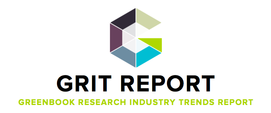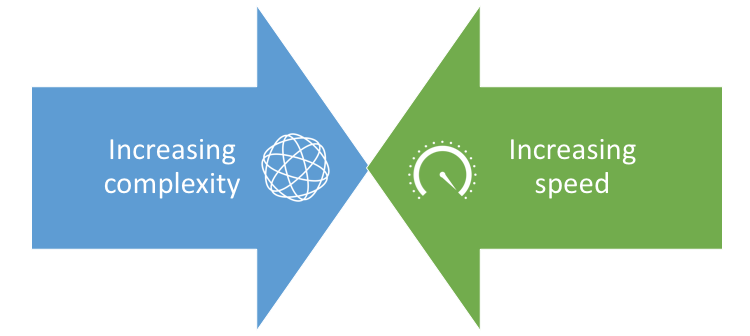|
Key themes for data and insights from the MRMW (Market Research in a Mobile World) Conference...and beyond. This is the world we live in: ever-increasing complexity with an ever-increasing drive for speed. There has been an exponential increase in the types and sources of data, and decision-making is becoming more nuanced.
Derek Franks, Global Director of Insights for EA, talked about Gregory Treverton's concept of puzzles versus mysteries, explaining that a puzzle has one clear right answer and is solved by collecting more data. Mysteries, on the other hand, can be hard to know if you've really solved, and they usually require making sense of the data you already have. We live in a world of mysteries! Things are changing at CPG behemoth Procter & Gamble as well. Julie Setser, VP of Innovation Capability, talked about how they look at data and insights as a "body of evidence" now versus the historic approach of one magic number (e.g. a purchase intent score). Consumer demand is driving faster innovation cycles, particularly in categories like technology, beauty, and fashion, and arguably across every consumer category to some extent. And in today's hyper-connected, social media savvy world, brands can't afford to miss an opportunity to react to customer feedback, both amplifying bright spots and fire-fighting when needed. Potential Solutions From a data and insights perspective, AI (artificial intelligence) and machine learning can automate time-intensive tasks and processes. AI chatbots can conduct adaptive surveys and even qualitative probing. Machine learning tools, like text analytics and sentiment analysis, can help keep a pulse on consumer reviews, brand posts, and other customer (dis)satisfaction data. For product development and innovation, many are embracing agile research approaches. Inspired by concepts like Lean Startup and Google's Design Sprints, this new breed of research is done in a compressed time period and is highly iterative. Instead of waiting for a near-final product and one big 'validation' test, agile research prioritizes the killer issues and tackles them in chunks, using an MVP (minimum viable product) approach or rough prototypes.
1 Comment
 Each year, Greenbook publishes the GRIT Report, a summary of market research industry trends based on a global survey of client and supply-side researchers. The findings are always insightful and help me better understand which research trends are really in play today and what’s coming next. Here are a few highlights from the most recent report that are particularly meaningful, along with some commentary from my experiences. What really matters in consumer research?
Which trends are hype and which are game-changers?
What are client’s unmet needs from research suppliers?
You can learn more by reading the full GRIT Report (free to download). If you’re in the market research industry, I also encourage you to sign up for the GRIT Panel to participate in future industry surveys and receive advance copies of the reports in your inbox.  Customer and market insights are some of the most critical elements in assessing future business opportunities, developing new products or services, and building existing businesses. Without understanding the customer, the market, the competition and the industry, how can anyone hope to compete and win in this fast-paced, ever changing world? Traditional market research can play an important role, but there isn’t always the time or money (or expertise) to execute large scale, formal research. There are also newer agile market research tools available on-line which can connect companies with customers faster and cheaper than ever. But what if research budgets are too limited for even those more agile approaches or there’s a low risk, early stage desire to learn broadly and just do some “back of the envelope” assessments? Good news: there are myriad sources and approaches available with virtually zero investment –here is a resource guide to get started. Market Size & Growth, Statistics and Trends Sources When evaluating a new market space for expansion, the first step is often to get a general idea of the size and growth of that market segment. Potential customer demographics and statistics can also help with estimating a new opportunity’s potential. Lastly, understanding key market and customer trends can help identify if a new opportunity is likely to be relevant or not and/or inspire new high-potential opportunity spaces. Syndicated research companies often use “freemium” models where that allow access certain reports or articles for free and the rest of the content and custom services are paid. These are always worth a search because, if available, the reports tend to be comprehensive and well-researched. · Euromonitor International: Country and Industry reports, market sizes & growth · IHS: Energy, economics, geopolitical risk, sustainability and supply chain management · Hartman Group: Reports and publications on health & wellness, sustainability, and generations. Non-profit fact tanks regularly publish reports and information to the public. These are great sources for trusty-worthy statistics to help business cases and identify new opportunity spaces. · Pew Research Center: Politics, media & news, social, religion, internet & tech · Kaiser Family Foundation: Health care statistics and reports · World Resources Institute: Research reports on sustainability, climate, natural resources Trend sites offer everything from the latest cool gadgets to scientific exploration of possible future scenarios. Many trend sites have free content on blog posts, via social media or will send free e-newsletters. · Springwise: Entrepreneurial and Innovation ideas · Institute for the Future: Foresight, future casting& scenarios, trends · Trendwatching: Global consumer trends, insights and innovations · The Futures Company: Trends in health, business, multicultural, sustainability, technology & generations Government sites often have estimates for certain market sizes, product groups or health conditions, etc. These are also great sources for demographic and population statistics. The sites below are focused on the US or Global, but other country’s government sites are also great sources of country-specific statistics. · United Nations Database: Economic statistics, social indicators, climate change, population, and more · CIA World Factbook: Almanac-style information by country on demographics, economy and more · Country Census Data: US-specific census data ranges from demographics to economic information and much more. · World Health Organization: Statistics on world health, including disease/condition incidence and key health indicators Industry & Competition Now that there’s a basic understanding of the size and growth potential of a particular market, it’s helpful to get a deeper sense of the industry and its players. This step tends to involve synthesizing many disparate data points, examples, case studies, and trends to develop a holistic story which can inform strategy choices and strengthen ideas. Different lenses can help teams create a robust view of the industry and existing (or potential) competition. · Think like a Customer—visit any retail locations or see if there are public tours of their facilities, shop their website or stores, talk to customer service agents or store staff, read customer reviews (e.g. product reviews on Amazon or user reviews on Yelp, etc.), look for company “lists” in the popular press (e.g. Forbes’ “Worlds’ Most Innovative Companies”, Working Mother’s “Best Companies for Working Moms”, etc.) · Think like an Investor (for publicly traded companies)—download the annual report, join an analysts’ call or read analysts reports, research the stock, search for financial articles and company profiles, look on investment/brokerage sites, set up a Google alert for news articles · Think like a Professional (especially for B2B): check out Professional and Industry Associations, visit trade shows and industry conferences, read trade journals/publications, look for public reports on Industry sites (private and government), check out the US Bureau of Labor Statistics site or the economic data on the US Census site (e.g. “Survey of Business Owners” or “Measuring the Electronic Economy”). · Think like a Student: look for case studies in business or higher education publications (e.g. Harvard Business Review or FastCompany), look for reports or articles published by big consulting companies (e.g. McKinsey), search Google Scholar for industry journal articles. Consult with the reference librarian at the local public library to access a variety of specialized reports and publications. Learning About New Ideas & Early Prototypes To start evaluating a new idea, feedback from others is critical. Think about expanding concentric circles, where first the feedback comes from colleagues or friends and then people with shared interests, followed by potential sellers and buyers—all of these interactions can be casual and conversational, just remember to stay in “information seeking” mode to maximize learning, don’t sell or defend the ideas to others. · Internal/Team Research: share the idea or prototype with fellow employees who are not closely associated with the project. This can be as informal as walking around the office and talking to people at their desks or over coffee, or as formal as scheduled interviews or filling out surveys. This approach is particularly useful for larger companies and/or highly confidential projects without IP protection. · Friends & Family Research: share the idea or prototype with friends and family and solicit their opinions, especially people who will be honest about their thoughts. If there’s a working prototype, it’s especially helpful to have friends try to use it in context and observe them. · Local Meet-Up or Networking Groups: join a local group focused on entrepreneurship, design thinking, lean start-up or innovation and share ideas for feedback during scheduled times or in informal networking (search for a group on Meet-Up). If it’s a new company start-up or uses a new business model, consider using a Business Model Canvas to communicate the idea simply and solicit feedback. · Talk to Potential Sellers: talk to store managers, salespeople and other selling professionals who might have experience with the product category or where the new product would potentially be sold. Do this informally and conversationally—reference their expertise and say their opinion would be really valuable. · Talk to Potential Buyers: If there’s a specific early customer niche, is there a way to tap into potential local groups that meet the criteria? For example, if it’s a pet product, visit a the local dog park, pooch in tow, and chat with other owners or, if it’s a new video game, ask to talk to a local gamers’ club—most people are happy to give their opinion about something they really care about. · Landing Pages & Crowd Funding: for certain ideas, trying to actual sell the product directly online (e.g. via Kickstarter or Indiegogo) can be a valuable learning experience. Never intentionally mislead people or take payment under false pretense, but by offering the chance to sign up to pre-order or for an email distribution update list, start-ups can begin to gauge interest before the product is ready to go. Create a custom landing page by using an intuitive website building site (e.g. Weebly or Wix), no coding necessary (minimal investment required to purchase a domain name if needed). Do-it-yourself, free market research can never completely take the place of well-designed, rigorously executed, and expertly analyzed customer and market research, particularly for higher-risk decisions and investments; however, in the early stages of market assessment and idea evaluation, it’s smart to take full advantage of the plethora of free resources available, including on-line information, publications, personal networks, and more. Think about it as applying the Pareto Principle, or “80/20 Rule”, free market research won’t provide all the answers or maybe even the exact answers needed, but it may be enough to give the 80% needed just to get started, support a hunch, or take an idea to the next level. |
AuthorSarah Faulkner, Owner Faulkner Insights Archives
July 2021
Categories
All
|


 RSS Feed
RSS Feed
